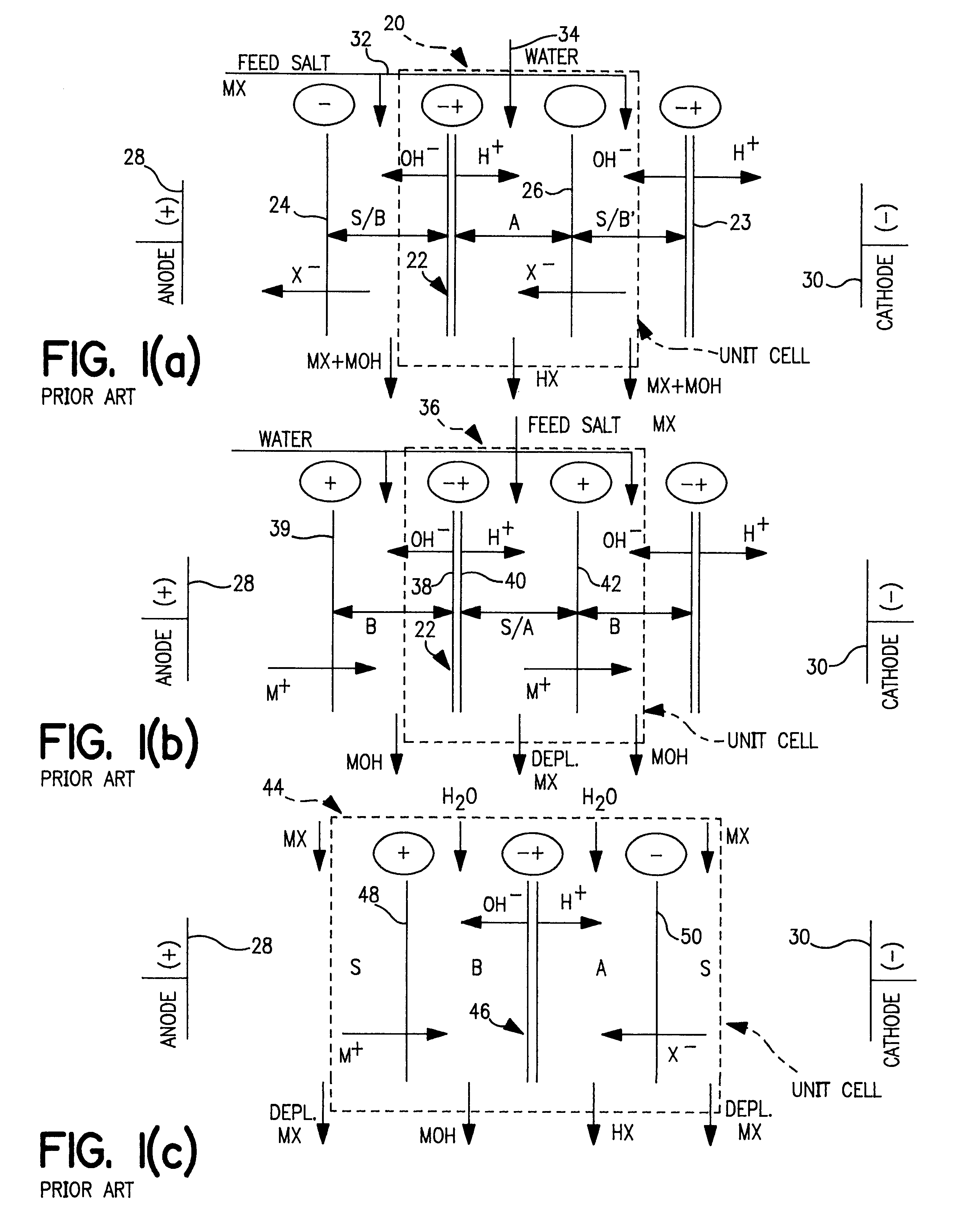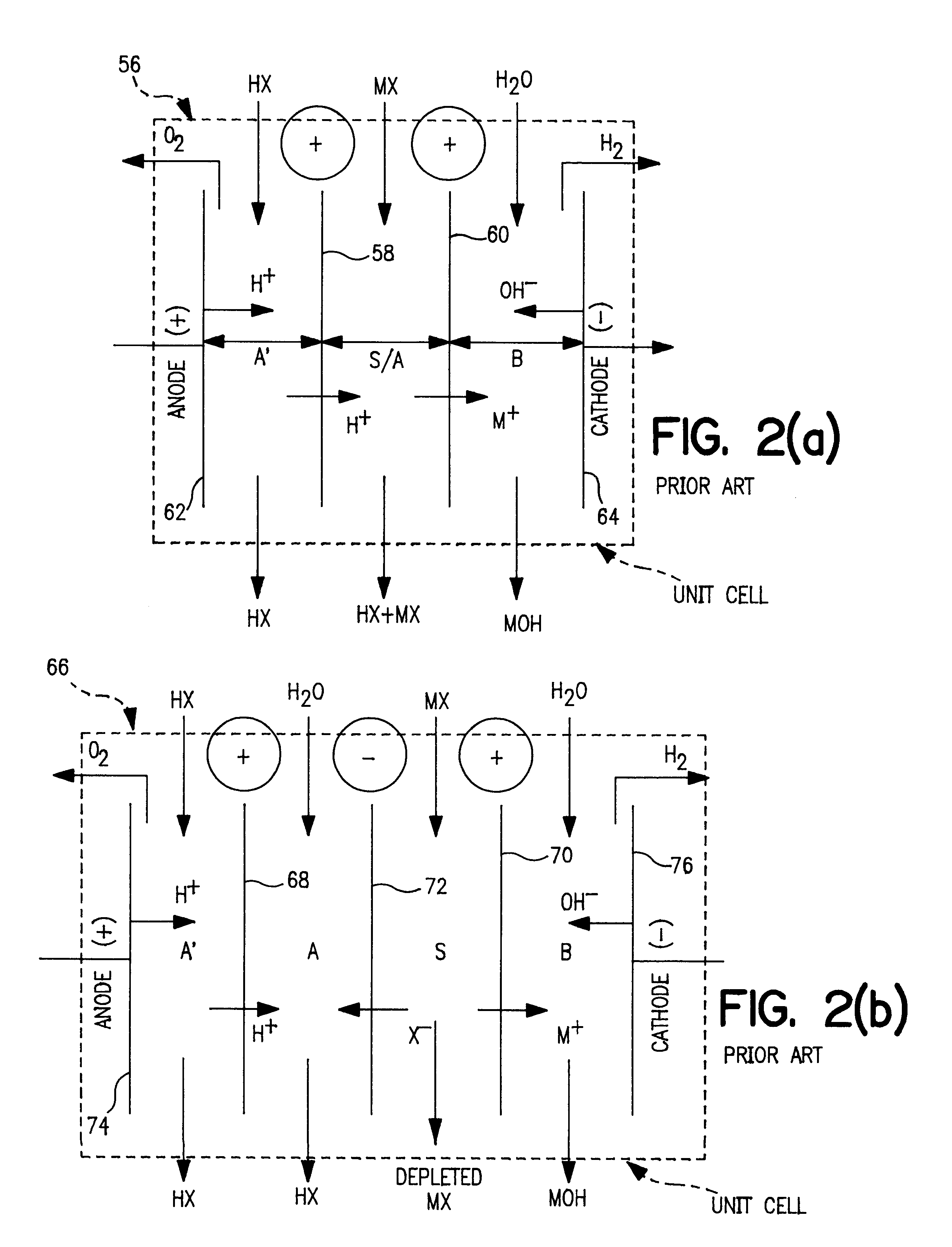Apparatus and process for electrodialysis of salts
a technology of apparatus and process, applied in the direction of fluid pressure measurement, liquid/fluent solid measurement, peptide, etc., can solve the problems of reducing current throughput, high capital and operating costs, and feed salts containing a significant amount of divalent metal ions, calcium and magnesium,
- Summary
- Abstract
- Description
- Claims
- Application Information
AI Technical Summary
Problems solved by technology
Method used
Image
Examples
example 1
The pilot cell was assembled with AQ bipolar membranes and CMV cation membranes. One hundred and six liters of ultrafiltered ammonium lactate solution was charged into the acid recycle tank 204 (FIG. 7). The conversion to acid was monitored through conductivity and pH measurements. The base loop 198 did not have an ion exchange column 206. The base tank 202 was initially charged with dilute ammonium hydroxide solution and as the ED process operated, the product ammonia solution overflowed from the base recycle tank 202. Small amounts of dilute NaCl solution were added to the base loop 198 to improve its conductivity. The process was deemed complete when the conductivity fell to around about 7 mS / cm.
The trial lasted approximately 15 hours. Samples of acid and base were collected and analyzed for lactic, ammonia and divalent metals. The results were as follows:
The trial produced 96 liters of product at a concentration of 87 gm / l. Ammonia removal was about 87%. As can be seen, the pH i...
example 2
The Example 1 was repeated after replacing the CMV cation membranes with AQ cation membranes. A hundred six and one half liters of the ammonium lactate feed were processed over 817 minutes to yield a product acid containing 1.58 gm / l NH.sub.3 at an average current input of 33.2 A (66.4 A / ft.sup.2). Ammonia removal was about 92%. The lactic loss via diffusion to the ammonia loop was about 2.8%. The overall current efficiency for the process was about 68%. However, metals analysis showed that the retention of the divalent metals was lower than for CMV; about 42% for magnesium, and about 37% for calcium. Therefore, the ammonia solution from the test had higher levels of dissolved metals: about 10-19 ppm calcium and 5-31 ppm magnesium. At the end of the experiment, the AQ cations were somewhat mottled in appearance, indicating possible fouling by the divalent cations.
example 3
Eight batches of ammonium lactate feed containing 70-92 gm / I lactate, with an initial conductivity of 28 to 42 mS / cm, were processed in the pilot cell. The cell contained AQ bipolar membranes, and CMV cation membranes that were used in Example 1. The input feed streams were subjected to ultrafiltration (200,000 Daltons cutoff). There was no ion exchange column 206 in the base loop 198. Ammonium hydroxide was at a concentration of 30-66 g / l and conductivity of 11 to 32 mS / cm was generated in the base loop 198. A diffusion of a small amount of lactic anion into the base loop 198 provided the requisite conductivity in the loop. No water or salt solution addition was made during these operations. The batches were of varying size and lasted from 6.35 to 40.3 hours. Each batch was terminated when the acid loop conductivity had decreased to about 7-10 mS / cm. During the batches, the ammonium ion concentration in the acid loop 196 dropped from 7-12 gm / l to 1.1-3.6 gm / l.
The total cell voltage...
PUM
| Property | Measurement | Unit |
|---|---|---|
| pKa | aaaaa | aaaaa |
| voltage | aaaaa | aaaaa |
| molecular weight | aaaaa | aaaaa |
Abstract
Description
Claims
Application Information
 Login to View More
Login to View More - R&D
- Intellectual Property
- Life Sciences
- Materials
- Tech Scout
- Unparalleled Data Quality
- Higher Quality Content
- 60% Fewer Hallucinations
Browse by: Latest US Patents, China's latest patents, Technical Efficacy Thesaurus, Application Domain, Technology Topic, Popular Technical Reports.
© 2025 PatSnap. All rights reserved.Legal|Privacy policy|Modern Slavery Act Transparency Statement|Sitemap|About US| Contact US: help@patsnap.com



